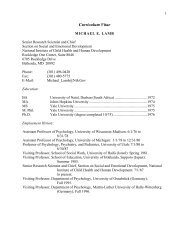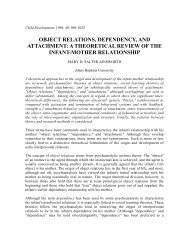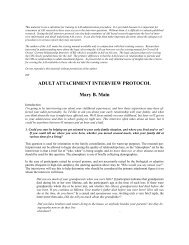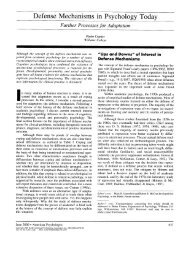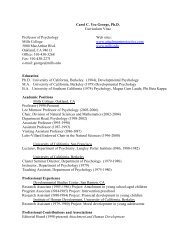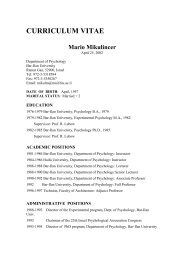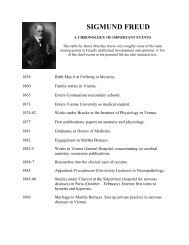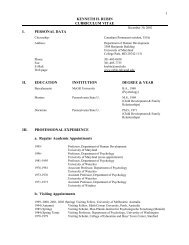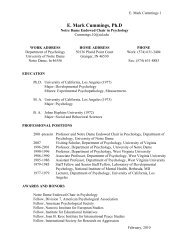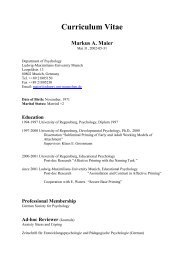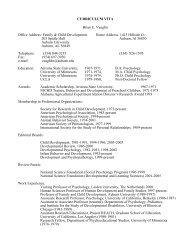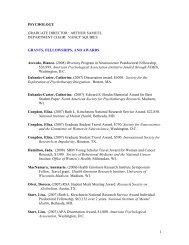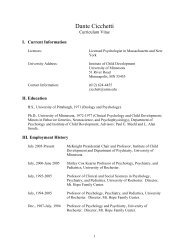Friendships and Adaptation in the Life Course - Psychology ...
Friendships and Adaptation in the Life Course - Psychology ...
Friendships and Adaptation in the Life Course - Psychology ...
Create successful ePaper yourself
Turn your PDF publications into a flip-book with our unique Google optimized e-Paper software.
358 HARTUP AND STEVENS<br />
pend<strong>in</strong>g on whe<strong>the</strong>r one counts unreciprocated as well as recip-<br />
rocated choices (Hall<strong>in</strong>an, 1980). This figure rema<strong>in</strong>s relatively<br />
constant dur<strong>in</strong>g adolescence <strong>and</strong> early adulthood (Cairns,<br />
Lueng, Buchanan, & Cairns, 1995), although to make compari-<br />
sons across studies is difficult because of methodological varia-<br />
tions. Network size is greatest among newlyweds, who report<br />
an average of 7.6 friends; <strong>the</strong>n decl<strong>in</strong>es to 4.7 aga<strong>in</strong> by middle<br />
age; <strong>and</strong> rises slightly (to 6.0) among persons about to retire<br />
(Lowenthal, Thurnher, & Chiriboga, 1975). Network size de-<br />
cl<strong>in</strong>es among older adults between Ages 55 <strong>and</strong> 90 (Dickens &<br />
Perlman, 1981; Dykstra, 1995b) due to mostly <strong>the</strong> loss of "ca-<br />
sual" friends. Close friends, however, are reta<strong>in</strong>ed <strong>in</strong>to old, old<br />
age, <strong>and</strong> older persons have about <strong>the</strong> same number of close<br />
friends as middle-aged adults (Field, 1995; Lang & Carstensen,<br />
1994). Girls' networks are ord<strong>in</strong>arily smaller <strong>and</strong> more exclu-<br />
sive than boys' dur<strong>in</strong>g early <strong>and</strong> middle childhood (Eder &<br />
Hall<strong>in</strong>an, 1978), but this situation reverses dur<strong>in</strong>g adolescence<br />
(Cairns et al., 1995 ). Gender differences <strong>in</strong> network size among<br />
adults are not consistent across <strong>the</strong> relevant studies.<br />
Third, time spent with friends varies over <strong>the</strong> life course,<br />
although estimates are extremely difficult to compare from <strong>in</strong>-<br />
vestigation to <strong>in</strong>vestigation; metrics <strong>and</strong> methods vary greatly.<br />
On <strong>the</strong> one h<strong>and</strong>, time spent with friends is greatest <strong>in</strong> middle<br />
childhood <strong>and</strong> adolescence, amount<strong>in</strong>g to 29% of time awake<br />
among teenagers. On <strong>the</strong> o<strong>the</strong>r h<strong>and</strong>, middle-aged adults spend<br />
only 7% of <strong>the</strong>ir time <strong>in</strong>teract<strong>in</strong>g with friends, <strong>and</strong> those over<br />
Age 65 spend 9% of <strong>the</strong>ir time this way (Larson & Bradney,<br />
1988; Larson, Zuzanek, & Mannell, 1985 ). Older women spend<br />
more time <strong>in</strong>teract<strong>in</strong>g with friends (<strong>and</strong> relatives) than men, <strong>and</strong><br />
widowed men <strong>and</strong> women spend more time with friends than<br />
married <strong>in</strong>dividuals (Altergott, 1988).<br />
Fourth, children who have friends at one age are likely to<br />
have <strong>the</strong>m at o<strong>the</strong>r ages (Elicker, Englund, & Sroufe, 1992),<br />
thus illustrat<strong>in</strong>g a cont<strong>in</strong>uity <strong>in</strong> social relations also suggested by<br />
retrospective <strong>in</strong>terviews with older persons. Based on <strong>in</strong>terviews<br />
with older participants, Mat<strong>the</strong>ws (1986) identified three "per-<br />
sonological" types as differentiated by friendship styles--<strong>in</strong>de-<br />
pendents enjoy friendly, satisfy<strong>in</strong>g social relationships through-<br />
out <strong>the</strong>ir lives but never have close or <strong>in</strong>timate friendS; discern-<br />
<strong>in</strong>g <strong>in</strong>dividuals report hav<strong>in</strong>g a small number of very close<br />
friends throughout childhood, adolescence, <strong>and</strong> adulthood; <strong>and</strong><br />
acquisitive <strong>in</strong>dividuals always have a relatively large number of<br />
friends <strong>and</strong> expect friends always to be available. Cont<strong>in</strong>uity is<br />
also suggested by <strong>the</strong> fact that close friends of many older<br />
persons are <strong>the</strong> same <strong>in</strong>dividuals who were <strong>the</strong>ir friends earlier<br />
<strong>in</strong> life (Field, 1995). Long-term friendships rest on shared his-<br />
tories, accumulated experiences, <strong>and</strong> simultaneously mov<strong>in</strong>g<br />
through major developmental transitions (Hess, 1972; Rawl<strong>in</strong>s,<br />
1992). Long-term cont<strong>in</strong>uities result from selection too: Old<br />
friends are consciously ma<strong>in</strong>ta<strong>in</strong>ed <strong>in</strong> preference to <strong>the</strong> mak<strong>in</strong>g<br />
of new ones <strong>in</strong>to very old age (Lang & Carstensen, 1994).<br />
Behavior With Friends <strong>and</strong> Nonfriends<br />
Behaviors that differentiate friends from nonfriends have been<br />
exam<strong>in</strong>ed <strong>in</strong> more than 80 studies with children <strong>and</strong> adolescents;<br />
<strong>the</strong> results generally verify <strong>the</strong> friendship deep <strong>and</strong> surface struc-<br />
tures described earlier. Reciprocity anchors <strong>the</strong>se relationships<br />
generally through <strong>the</strong> first 2 decades; surface content changes<br />
with age. Several narrative reviews of <strong>the</strong>se studies have been<br />
published (Hartup, 1989, 1996) as well as a meta-analysis (A.<br />
F. Newcomb & Bagwell, 1995 ). In <strong>the</strong>se studies, researchers did<br />
not demonstrate <strong>the</strong> developmental significance of friendships<br />
directly but specified some of <strong>the</strong> social processes through<br />
which friendship experience <strong>and</strong> adaptation are l<strong>in</strong>ked.<br />
We summarize one representative <strong>in</strong>vestigation <strong>in</strong> this article<br />
• along with <strong>the</strong> meta-analytic results as a basis for <strong>the</strong> rema<strong>in</strong>der<br />
of <strong>the</strong> review. In an empirical study, Hartup, Daiute, Zajac,<br />
<strong>and</strong> Sholl (1995) exam<strong>in</strong>ed conversations between friends <strong>and</strong><br />
nonfriends (10-year-olds) <strong>in</strong> an <strong>in</strong>nercity magnet school while<br />
<strong>the</strong> children wrote stories collaboratively on a computer, Stories<br />
were about <strong>the</strong> tropical ra<strong>in</strong> forest--a'subject matter that <strong>the</strong><br />
children had studied dur<strong>in</strong>g a 6-week science project. Children<br />
were assigned to three groups: (a) those who wrote stories<br />
<strong>in</strong>dividually on 4 different days; (b) those who wrote <strong>in</strong>dividu-<br />
ally on Day 1, <strong>the</strong>n <strong>the</strong> next 2 with a friend, <strong>and</strong> <strong>the</strong> f<strong>in</strong>al day<br />
alone; <strong>and</strong> (c) those who collaborated with a nonfriend ra<strong>the</strong>r<br />
than a friend. Results <strong>in</strong>dicate that friends did not talk more<br />
dur<strong>in</strong>g collaboration than nonfriends but, never<strong>the</strong>less, (a) en-<br />
gaged <strong>in</strong> more mutually oriented <strong>and</strong> fewer <strong>in</strong>dividualistic utter-<br />
ances; (b) agreed with one ano<strong>the</strong>r more often (but did not<br />
disagree more readily); (c) repeated <strong>the</strong>ir own <strong>and</strong> friend's<br />
assertions more often; (d) posed alternatives <strong>and</strong> provided elab-<br />
orations more frequently; (e) spent twice as much time as non-<br />
friends talk<strong>in</strong>g about writ<strong>in</strong>g content, <strong>the</strong> vocabulary used, <strong>and</strong><br />
writ<strong>in</strong>g mechanics; <strong>and</strong> (f) spent less time engaged <strong>in</strong> "off-<br />
task" talk. Pr<strong>in</strong>cipal component analyses confirm that friends'<br />
talk was assertively collaborative--a f<strong>in</strong>d<strong>in</strong>g that is rem<strong>in</strong>iscent<br />
of <strong>the</strong> dialogues between experts <strong>and</strong> novices reported <strong>in</strong> o<strong>the</strong>r<br />
social problem-solv<strong>in</strong>g studies (Rogoff, 1990). The stories also<br />
show that, overall, <strong>the</strong> ones written collaboratively by friends<br />
were better than those written by nonfriends--a difference that<br />
seems to rest on <strong>the</strong> better use of st<strong>and</strong>ard English by friends<br />
ra<strong>the</strong>r than <strong>the</strong> narrative elements <strong>in</strong>cluded <strong>in</strong> <strong>the</strong> stories.<br />
The meta-analysis (A. E Newcomb & Bagwell, 1995) sum-<br />
marizes friend versus nonfriend differences among children <strong>and</strong><br />
adolescents <strong>in</strong> terms of four broad b<strong>and</strong> categories: positive<br />
engagement (i.e., more talk, smil<strong>in</strong>g, <strong>and</strong> laughter generally<br />
occur among friends than nonfriends), conflict management<br />
(i.e., friends use disengagement <strong>and</strong> negotiation vs. power asser-<br />
tion proportionally more frequently than nonfriends), task activ-<br />
ity (i.e. task orientation as opposed to off-task orientation is<br />
greater among friends than nonfriends), <strong>and</strong> relationship proper-<br />
ties (i.e., equality <strong>in</strong> <strong>the</strong> exchange as well as mutuality <strong>and</strong><br />
affirmation are greater among friends than nonfriends). The<br />
data with<strong>in</strong> <strong>and</strong> across studies show that, behaviorally speak<strong>in</strong>g,<br />
<strong>the</strong> relationship affordances of "be<strong>in</strong>g friends" differ from <strong>the</strong><br />
affordances of "be<strong>in</strong>g acqua<strong>in</strong>tances." Friends are socially ac-<br />
tive with one ano<strong>the</strong>r, <strong>and</strong> <strong>the</strong>ir <strong>in</strong>teraction is marked by mutual-<br />
ity, effective conflict management, <strong>and</strong> task orientation, <strong>the</strong>reby<br />
reflect<strong>in</strong>g <strong>the</strong> deep structure revealed <strong>in</strong> <strong>the</strong> descriptions of<br />
friends (L. Weiss & Lowenthal, 1975).<br />
Certa<strong>in</strong> changes <strong>in</strong> <strong>the</strong> <strong>in</strong>teraction between friends can be<br />
observed with <strong>the</strong> onset of adolescence, although <strong>the</strong>se ex-<br />
changes rema<strong>in</strong> anchored <strong>in</strong> reciprocation. First, although nega-<br />
tive gossip occurs more commonly <strong>in</strong> talk between friends than<br />
between nonfriends throughout childhood <strong>and</strong> adolescence, pos-<br />
itive gossip differentiates friends <strong>and</strong> acqua<strong>in</strong>tances only <strong>in</strong> ado-<br />
lescence. Second, self-disclosure newly differentiates among<br />
friends <strong>and</strong> acqua<strong>in</strong>tances <strong>in</strong> adolescence <strong>and</strong> so does m<strong>in</strong>dread-



